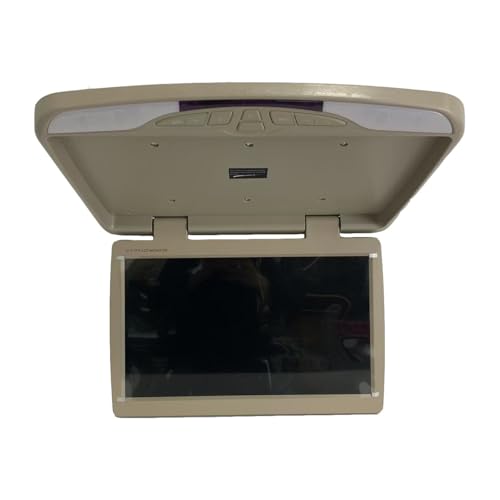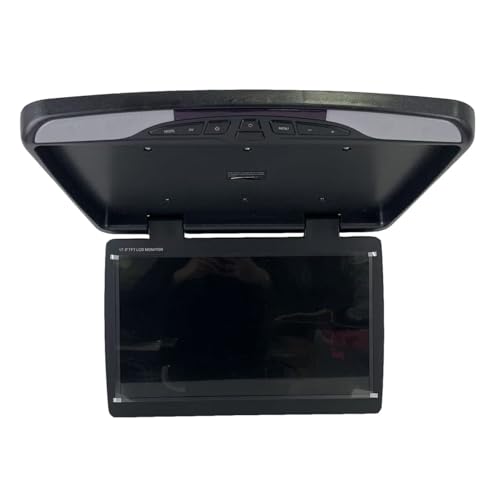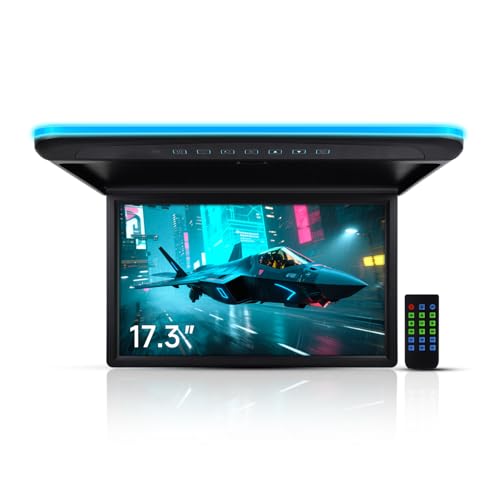For years, I struggled with finding a compact, reliable display solution for my various tech projects. Whether it was setting up a Raspberry Pi, extending my laptop screen on the go, or configuring a CCTV system, the lack of a suitable small monitor was a constant headache. It meant lugging around larger, unwieldy screens or compromising on visual feedback, which often led to frustrating debugging sessions and inefficient workflows. The need for a dedicated, multi-purpose display, like the Padarsey 7 inch Monitor HDMI, became incredibly apparent to simplify these tasks and ensure seamless operation.
- 1) Working perfect with CCTV Computer PC Raspberry Pi 3, 2 and Raspberry Pi 1 B B+
- 2) Easy to use and operate; Comes with an IR remote controller for a easy operation.
- 3) High-Resolution Picture.Full Color Display.Low Power Consumption
Key Considerations Before Investing in a Compact Display
Before diving into the specifics of a compact monitor, it’s crucial to understand why someone might need one and what factors should guide their purchase. Small monitors, typically ranging from 5 to 10 inches, are invaluable for niche applications where full-sized displays are impractical or overkill. They often serve as dedicated screens for single-board computers like Raspberry Pi, on-the-go displays for diagnostics, or components in custom embedded systems. The ideal customer for such a product is often a hobbyist, an electronics enthusiast, a DIY smart home builder, or a professional needing a portable diagnostic screen for CCTV or automotive systems. These users prioritize versatility, compact size, and multiple input options over high resolution or large screen real estate.
Conversely, someone looking for a primary display for graphic design, gaming, or general office work should absolutely not consider a monitor in this category. For those needs, a larger, higher-resolution monitor (24 inches and up, with 1080p or 4K resolution) would be far more suitable. Before making a purchase, ask yourself: What will be the primary use case? How critical are portability and space-saving? What input types do I need (HDMI, VGA, AV)? Is a built-in speaker important? And crucially, what level of display quality (resolution, viewing angles) is acceptable for my specific application?
- 17.3" Digital TFT LCD Screen: This monitor delivers a truly immersive viewing experience, displays more content and resolves sharper images;
- 17.3" Digital TFT LCD Screen: Perfect choice for large vehicles such as buses, coaches, motor homes ... This monitor delivers a truly immersive viewing experience, displays more content and resolves...
- The YHRF173M features a 17.3-inch large digital screen. It is specifically designed for bigger vehicles such as coaches, buses, and motor homes. This roof monitor is a perfect fit for such vehicles.
Introducing the Padarsey 7-Inch HDMI Monitor
The Padarsey 7 inch Monitor HDMI positions itself as a highly versatile and compact display solution. It promises seamless integration with a wide array of devices, from Raspberry Pi boards to CCTV systems, PCs, and even car DVRs. When you purchase this Padarsey monitor, you typically receive the 7-inch LCD screen itself, an IR remote controller for easy navigation, and often a power adapter, and possibly an HDMI cable. Compared to some market leaders that might specialize in higher-end portable monitors for laptops, the Padarsey excels in offering a comprehensive suite of legacy and modern inputs at an accessible price point, making it a compelling choice for multi-platform compatibility rather than just high-fidelity display. This specific 7 inch Monitor HDMI is truly designed for the tinkerer, the system builder, and anyone needing a dedicated, small display for monitoring or initial setup without complex configurations. It’s not for those expecting a pristine, colour-accurate display for media consumption or professional creative work.
Pros:
* Highly Versatile Inputs: Features HDMI, VGA, and AV ports, making it compatible with a vast range of devices.
* Compact & Portable: Its 7-inch size is ideal for small setups, embedded projects, or on-the-go use.
* Built-in Speaker: Offers convenient audio output without needing external speakers.
* Included IR Remote: Simplifies navigation through menus and input switching.
* Low Power Consumption: Efficient operation, suitable for various power sources.
Cons:
* Modest Resolution: 1024×600 resolution is functional but not high-definition for detailed text or graphics.
* Viewing Angles: TFT LCD technology means viewing angles can be limited, requiring direct alignment for optimal clarity.
* Build Quality: The plastic casing feels somewhat basic, and while functional, it doesn’t exude premium durability.
* Potential for Quality Control Issues: Some user reports suggest occasional problems with unit reliability or functionality out of the box.
Deep Dive into Features and Their Advantages
Having used the Padarsey 7 inch Monitor HDMI for an extended period, I’ve come to appreciate its core features and how they address specific needs. This monitor isn’t about groundbreaking technology; it’s about practical functionality and broad compatibility, making it an indispensable tool for anyone juggling various tech projects.
Multi-Input Versatility: HDMI, VGA, and AV
The standout feature of this Padarsey monitor is undoubtedly its comprehensive input selection. Boasting HDMI, VGA, and AV ports, it’s rare to find a device that can’t connect to it. From modern HDMI-enabled devices like Raspberry Pi 3 Model B+, laptops, and game consoles, to older VGA-only PCs or even composite video sources like older CCTV cameras or DVD players, this monitor handles them all.
How it performs: Switching between inputs is straightforward using the included IR remote or the buttons on the unit itself. The monitor quickly detects the active input, making transitions seamless. I’ve personally used it with my Raspberry Pi for coding projects, connected it via VGA to an old desktop tower when troubleshooting, and even hooked up a vintage game console using the AV input. Each connection worked flawlessly, displaying clear images appropriate for the resolution.
Why it’s important: This versatility is crucial because it eliminates the need for multiple specialized displays or cumbersome adapters. For a hobbyist, it means one monitor can serve dozens of different projects. For a professional, it means quicker diagnostics in diverse environments without compatibility headaches. Imagine troubleshooting an old industrial PC with a VGA output one moment and then connecting to a modern network video recorder (NVR) via HDMI the next – the 7-inch display handles it with ease, solving the core problem of display incompatibility across a wide range of hardware. This saves time, reduces clutter, and ultimately, saves money by not requiring additional hardware.
Compact 7-inch Size and 1024×600 HD Resolution
The physical dimensions of the Padarsey 7 inch Monitor HDMI are key to its utility. At 7 inches, it strikes a perfect balance between being large enough to display readable text and small enough to be incredibly portable and space-efficient. The 1024×600 resolution, while not full HD, is perfectly adequate for this screen size.
How it performs: The resolution translates to a crisp image for its size. Text on a Raspberry Pi desktop environment is perfectly readable, and video feeds from CCTV cameras are clear enough to discern details. While you won’t be enjoying 4K movies or doing intricate graphic design, for tasks like monitoring server logs, displaying sensor data, or simply providing a visual interface for a headless system, it performs admirably. The 16:9 aspect ratio is standard, ensuring content isn’t stretched or distorted. I’ve often mounted this this display inside project enclosures or used it as a temporary display on a crowded workbench.
Why it’s important: The compact size directly solves the problem of limited space. For car dashboards, small kiosks, or integrating into custom-built systems, larger monitors are simply not an option. The resolution, though modest, provides enough detail for practical applications without demanding high processing power from the connected device. This makes it ideal for low-power systems like Raspberry Pi or older computers. It helps solve the core problem of needing a dedicated, compact visual interface where larger, high-resolution screens would be impractical or unnecessary, ensuring your project remains streamlined and efficient.
Integrated Built-in Speaker
While not a feature that will blow audiophiles away, the inclusion of a built-in speaker on the Padarsey 7 inch Monitor HDMI is a surprising convenience.
How it performs: The speaker provides basic audio output, sufficient for system sounds, simple video playback, or hearing audio from a CCTV feed. The volume can be adjusted via the remote. Don’t expect booming bass or crystal-clear highs, but it gets the job done when you need to confirm audio is working or simply don’t have external speakers available. For instance, when setting up a Raspberry Pi with a media centre, having immediate audio feedback without extra peripherals is very handy.
Why it’s important: This feature eliminates the need for external speakers in many situations, reducing clutter and simplifying setup, especially in space-constrained environments or portable applications. It means one less cable to manage and one less component to power, contributing to the overall simplicity and portability of the setup. It solves the problem of needing rudimentary audio output without additional hardware, making the monitor a truly all-in-one compact solution.
IR Remote Controller for Easy Operation
The included IR remote control might seem like a small detail, but its impact on usability is significant, especially for a monitor that might be placed out of arm’s reach or integrated into a system.
How it performs: The remote allows you to easily power the monitor on/off, switch between the various video inputs (HDMI, VGA, AV), and navigate the on-screen display (OSD) menu to adjust brightness, contrast, colour, and other settings. This is particularly useful when the monitor is part of a larger, fixed installation like a car entertainment system or a security setup, where direct access to physical buttons might be inconvenient. I’ve found it incredibly useful when the monitor is just out of reach on my workbench, avoiding the need to lean over or move components.
Why it’s important: The remote enhances the user experience by providing effortless control over the display settings and input selection. It solves the problem of difficult accessibility to physical buttons in certain installation scenarios and simply adds a layer of convenience to daily use, making the this versatile monitor more practical for diverse applications.
Low Power Consumption and 12V DC Input
The Padarsey 7 inch Monitor HDMI is designed with efficiency in mind, operating on a 12V DC power input.
How it performs: The monitor draws minimal power, making it suitable for long-term operation without significant energy costs. The 12V input is standard, meaning it can be powered by various sources, including wall adapters (often included), car batteries, or even portable power banks (with the right converter), further enhancing its portability and versatility. I’ve successfully run it off a small 12V battery pack for portable diagnostics in the field.
Why it’s important: Low power consumption is vital for applications where the monitor needs to run continuously or where power sources are limited. It makes the monitor ideal for automotive use, off-grid projects, or battery-powered portable setups. It helps solve the problem of requiring a display that is energy-efficient and flexible in its power requirements, ensuring it can be integrated into almost any environment without specialized power infrastructure.
Broad Compatibility: Raspberry Pi, CCTV, PC, Car DVR
As highlighted in its description, this Padarsey 7 inch Monitor HDMI is explicitly designed for compatibility with a wide range of devices.
How it performs:
* Raspberry Pi: It works perfectly with Raspberry Pi 3 Model B+, 3B, 2, and 1 B/B+, requiring minimal setup. The resolution is well-supported, making it an excellent display for Pi projects, from retro gaming consoles to home automation dashboards.
* CCTV & DVR: The AV input is fantastic for older analogue CCTV cameras, while HDMI is perfect for modern DVR/NVR systems, providing clear security feeds. Its compact size means it can be mounted unobtrusively for monitoring.
* Computer PC: Connect it via HDMI or VGA as a secondary display, a diagnostic monitor, or for mini-PC setups where space is premium.
* Car: Its 12V input and compact form factor make it an obvious choice for car rearview cameras, DVD players, or custom in-car entertainment systems.
Why it’s important: This extensive compatibility means the monitor is incredibly adaptable. You don’t need a different screen for each of your projects or systems. It’s a single solution that serves many purposes, significantly reducing hardware clutter and cost. This directly solves the problem of needing a truly universal compact display for diverse technological ecosystems, making it a highly practical and economical choice.
What Others Are Saying: User Experiences
Having spent considerable time with this Padarsey 7 inch Monitor HDMI, I’ve also taken the opportunity to review feedback from other users across the internet. While many share my positive experiences regarding its versatility and multi-input capabilities, some users, unfortunately, reported encountering issues right out of the box. A few mentioned receiving units that would only flash on and off or were completely unresponsive to power, even after trying multiple outlets or car setups, suggesting occasional manufacturing defects or damage during transit. There were also isolated instances where users received monitors with inverted displays or menu orientations that couldn’t be corrected, indicating potential firmware issues or quality control oversights. These experiences, while not universal, highlight the importance of thorough testing upon arrival.
Final Thoughts and Recommendations
The challenge of finding a small, versatile display that can adapt to a myriad of modern and legacy tech devices is a common one for enthusiasts and professionals alike. Without a dedicated solution, projects can stall, troubleshooting becomes a chore, and overall efficiency suffers. The Padarsey 7 inch Monitor HDMI expertly addresses this gap, providing a compact yet powerful visual interface.
It stands out due to its comprehensive multi-input support (HDMI, VGA, AV), allowing seamless integration with everything from Raspberry Pis to CCTV cameras. Its compact 7-inch size makes it incredibly portable and ideal for space-constrained applications. Lastly, features like the built-in speaker and IR remote add significant convenience, enhancing the user experience. If you’re a hobbyist, a DIY enthusiast, or someone needing a reliable, versatile secondary display for diagnostics or embedded projects, this monitor is a superb choice. To learn more and see if it’s the right fit for your needs, Click here to check out this monitor .
Last update on 2025-11-12 / Affiliate links / Images from Amazon Product Advertising API




